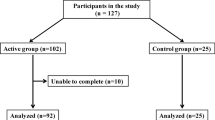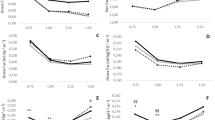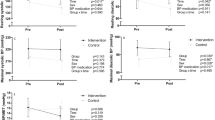Abstract
OBJECTIVE: To compare the effects of different patterns of brisk walking on day-long plasma triacylglycerol concentrations in sedentary adults.
DESIGN: A three-trial, repeated measures design in which subjects were studied in the fasted state and throughout a day during which they consumed three standardized, mixed meals. On different occasions, subjects undertook no exercise (control), walked briskly for 10 min before each meal (short walks) or walked briskly for 30 min before breakfast (long walk).
SUBJECTS: Seven postmenopausal sedentary women and three sedentary men aged between 34 and 66 y, with body mass index between 24 and 35 kg/m2.
MEASUREMENTS: Plasma concentrations of triacylglycerol, non-esterified fatty acids, glucose and insulin, metabolic rate and whole-body substrate oxidation in the fasted state and at hourly intervals for 3 h after each meal.
RESULTS: Postprandial plasma triacylglycerol concentrations were lower (P=0.009) during the walking trials than during the control trial (average values: control 2.08±0.28 mmol/l; short walks 1.83±0.22 mmol/l; long walk 1.84±0.22 mmol/l (mean±s.e.) but did not differ between the two patterns of walking. The difference between control and walking trials increased as successive meals were consumed (interaction of trial×meal P=0.03). Plasma triacylglycerol concentration increased during the 3 h after breakfast, changed little after lunch and decreased after the evening meal (interaction of meal×time P=0.001). When both walking trials were treated as one condition, walking increased postprandial fat oxidation (average values: control, 0.066±0.009 g/min; walking 0.074± 0.008 g/min; P<0.01).
CONCLUSIONS: Thirty minutes of brisk walking, undertaken in one session or accumulated throughout a day, reduces postprandial plasma triacylglycerol concentrations and increases fat oxidation.
This is a preview of subscription content, access via your institution
Access options




Similar content being viewed by others
References
Pate RR, Pratt M, Blair SN, Haskell WL, Macera CA, Bouchard C, Buchner D, Ettinger W, Heath GW, King AC, Kriska A, Leon AS, Marcus BH, Morris J, Paffenbarger RS, Patrick K, Pollock ML, Rippe JM, Sallis J, Wilmore JH . Physical activity and public health. A recommendation from the Centers for Disease Control and Prevention and the American College of Sports Medicine JAMA 1995 273: 402–407.
Pollock ML, Gaesser GA, Butcher JD, Després J-P, Dishman RK, Franklin BA, Ewing Garber C . The recommended quantity and quality of exercise for developing and maintaining cardiorespiratory and muscular fitness, and flexibility in healthy adults Med Sci Sports Exerc 1998 30: 975–991.
Paffenbarger RS, Hyde RT, Wing AL, Hsieh C-C . Physical activity, all-cause mortality, and longevity of college alumni New Engl J Med 1986 314: 605–613.
Helmrich SP, Ragland DR, Leung RW, Paffenbarger RS . Physical activity and reduced occurrence of non-insulin-dependent diabetes mellitus New Engl J Med 1991 325: 147–152.
Thune I, Brenn T, Lund E, Gaard M . Physical activity and the risk of breast cancer New Engl J Med 1997 336: 1269–1275.
Magnus K, Matroos A, Strackee J . Walking, cycling, or gardening, with or without seasonal interruption, in relation to coronary events Am J Epidemiol 1979 110: 724–733.
DeBusk RF, Stenestrand U, Sheehan M, Haskell WL . Training effects of long versus short bouts of exercise in healthy subjects Am J Cardiol 1990 65: 1010–1013.
Jakicic JM, Wing RR, Butler BA, Robertson RJ . Prescribing exercise in multiple short bouts versus one continuous bout: effects on adherence, cardiorespiratory fitness, and weight loss in overweight women Int J Obes Relat Metab Disord 1995 19: 893–901.
Murphy MH, Hardman AE . Training effects of short and long bouts of brisk walking in sedentary women Med Sci Sports Exerc 1998 30: 152–157.
Patsch JR, Miesenböck G, Hopferwieser T, Muhlberger V, Knapp E, Dunn JK, Gotto AM, Patsch W . Relation of triglyceride metabolism and coronary artery disease. Studies in the postprandial state Arterioscler Thromb 1992 12: 1336–1345.
Stampfer MJ, Krauss RM, Ma J, Blanche PJ, Holl LG, Sacks FM, Hennekens CH . A prospective study of triglyceride level, low-density lipoprotein particle diameter, and risk of myocardial infarction JAMA 1996 276: 882–888.
Miesenböck G, Patsch JR . Postprandial hyperlipidemia: the search for the atherogenic lipoprotein Curr Opin Lipidol 1992 3: 196–201.
Karpe F, Hamsten A . Postprandial lipoprotein metabolism and atherosclerosis Curr Opin Lipidol 1995 6: 123–129.
Gill JMR, Hardman AE . The effect of a single exercise session on postprandial chylomicron, very low density lipoprotein and total plasma triacylclygerol concentrations Proc Nutr Soc 2000 71: 465–471.
Tsetsonis NV, Hardman AE, Mastana SS . Acute effects of exercise on postprandial lipemia: a comparative study in trained and untrained middle-aged women Am J Clin Nutr 1997 65: 525–533.
Tsetsonis NV, Hardman AE . Reduction in postprandial lipemia after walking: influence of exercise intensity Med Sci Sports Exerc 1996 28: 1235–1242.
Gill JMR, Hardman AE . Postprandial lipemia: effects of exercise of and restriction of energy intake compared Am J Clin Nutr 2000 71: 465–471.
Borg GAV . Psychophysical bases of perceived exertion Med Sci Sports Exerc 1982 14: 377–387.
Dill DB, Costill DL . Calculation of percentage changes in volumes of blood, plasma, and red cells in dehydration J Appl Physiol 1974 37: 247–248.
Schlierf G, Dinsenbacher A, Kather H, Kohlmeier M, Haberbosch W . Mitigation of alimentary lipemia by postprandial exercise: phenomena and mechanisms Metabolism 1987 36: 726–730.
Hardman AE, Aldred HE . Walking during the postprandial period decreases alimentary lipaemia J Cardiovasc Risk 1995 2: 71–78.
Jakicic JM, Wing RR, Butler BA, Robertson RJ . Prescribing exercise in multiple short bouts versus one continuous bouts: effects on adherence, cardiorespiratory fitness, and weight loss in overweight women Int J Obes Relat Metab Disord 1995 19: 893–901.
Snyder KA, Donnelly JE, Jabobsen DJ, Hertner G, Jakicic JM . The effects of long-term, moderate intensity, intermittent exercise on aerobic capacity, body composition, blood lipids, insulin and glucose in overweight females Int J Obes Relat Metab Disord 1997 21: 1180–1189.
Le Fur C, Romon M, Lebel P, Devos P, Lancry A, Guédon-Moreau L, Fruchart J-C, Dallongeville J . Influence of mental stress and circadian cycle on postprandial lipemia Am J Clin Nutr 1999 70: 213–220.
Coppack SW, Fisher RM, Gibbons GF, Frayn KN . Post-prandial substrate deposition in human forearm and adipose tissues in vivo Clin Sci 1990 79: 339–348.
Pagano Mirani-Oostdijk C, Havekes L, Terpstra J, Frölich M, Van Gent CM, Jansen H . Diurnal changes in serum triglycerides as related to changes in lipolytic enzymes, (apo) lipoproteins and hormones in normal subjects on a carbohydrate-rich diet Eur J Clin Invest 1983 13: 301–309.
Coppack SW, Yost TJ, Fisher RM, Eckel RH, Miles JM . Periprandial systemic and regional lipase activity in normal humans Am J Physiol 1996 270: E718–E722.
Farese RV, Yost TJ, Eckel RH . Tissue-specific regulation of lipoprotein lipase activity by insulin/glucose in normal-weight humans Metabolism 1991 40: 214–216.
Kiens B, Lithell H, Mikines KJ, Richter E . Effects of insulin and exercise on muscle lipoprotein lipase activity in man and its relation to insulin action J Clin Invest 1989 84: 1124–1129.
Seip RL, Angelopoulos TJ, Semenkovich CF . Exercise induces human lipoprotein lipase gene expression in skeletal muscle but not adipose tissue Am J Physiol 1995 268: E229–E236.
Kaijser L, Rössner S . Removal of exogenous triglycerides in human forearm muscle and subcutaneous tissue Acta Med Scand 1975 197: 289–294.
Rowell LB . Human Cardiovascular Control Oxford: Oxford University Press 1993.
Eriksen M, Waaler BA . Priority of blood flow to splanchnic organs in humans during pre- and post-meal exercise Acta Physiol Scand 1994 150: 363–372.
Sniderman AD, Cianflone K . Substrate delivery as a determinant of hepatic apoB secretion Arterioscler Thromb 1993 13: 629–636.
Herd SL, Hardman AE, Vora V . Influence of brisk walking duration on postprandial lipemia and plasma lipoprotein lipase activity Med Sci Sports Exerc 1997 29: S6.
MacAuley D, McCrum EE, Stott G, Evans EE, Sweeney K, Trinick TR, Boreham CAG . The Northern Ireland Health and Activity Survey Belfast: HMSO 1994.
Strain JJ, Barker ME, Livingstone MBE, McKenna PG . The Northern Ireland dietary survey and related studies Proc Nutr Soc 1990 49: 289–296.
Acknowledgements
The authors wish to thank Dr A Mardhavan and Dr S Friers from Whiteabbey Hospital for assistance with venous cannulation, Dr M O'Hare and Ms B McKibben from the Institute of Clinical Science at the Queens University of Belfast for performing insulin analyses, Dr John Brown from the University of Ulster at Jordanstown for help with plasma lipid analyses and Mr T Ross for help with data collection.
Author information
Authors and Affiliations
Corresponding author
Rights and permissions
About this article
Cite this article
Murphy, M., Nevill, A. & Hardman, A. Different patterns of brisk walking are equally effective in decreasing postprandial lipaemia. Int J Obes 24, 1303–1309 (2000). https://doi.org/10.1038/sj.ijo.0801399
Received:
Revised:
Accepted:
Published:
Issue Date:
DOI: https://doi.org/10.1038/sj.ijo.0801399
Keywords
This article is cited by
-
The Effects of Accumulated Versus Continuous Exercise on Postprandial Glycemia, Insulin, and Triglycerides in Adults with or Without Diabetes: A Systematic Review and Meta-Analysis
Sports Medicine - Open (2022)
-
Is achieving 7,000 steps/day cross-sectionally and prospectively associated with older adults’ lower-extremity performance?
BMC Geriatrics (2021)
-
Postprandial lipemic and inflammatory responses to high-fat meals: a review of the roles of acute and chronic exercise
Nutrition & Metabolism (2016)
-
The effect of moderate intensity exercise in the postprandial period on the inflammatory response to a high-fat meal: an experimental study
Nutrition Journal (2015)
-
Effects of continuous versus accumulated activity patterns on postprandial triacylglycerol concentrations in obese men
International Journal of Obesity (2008)



